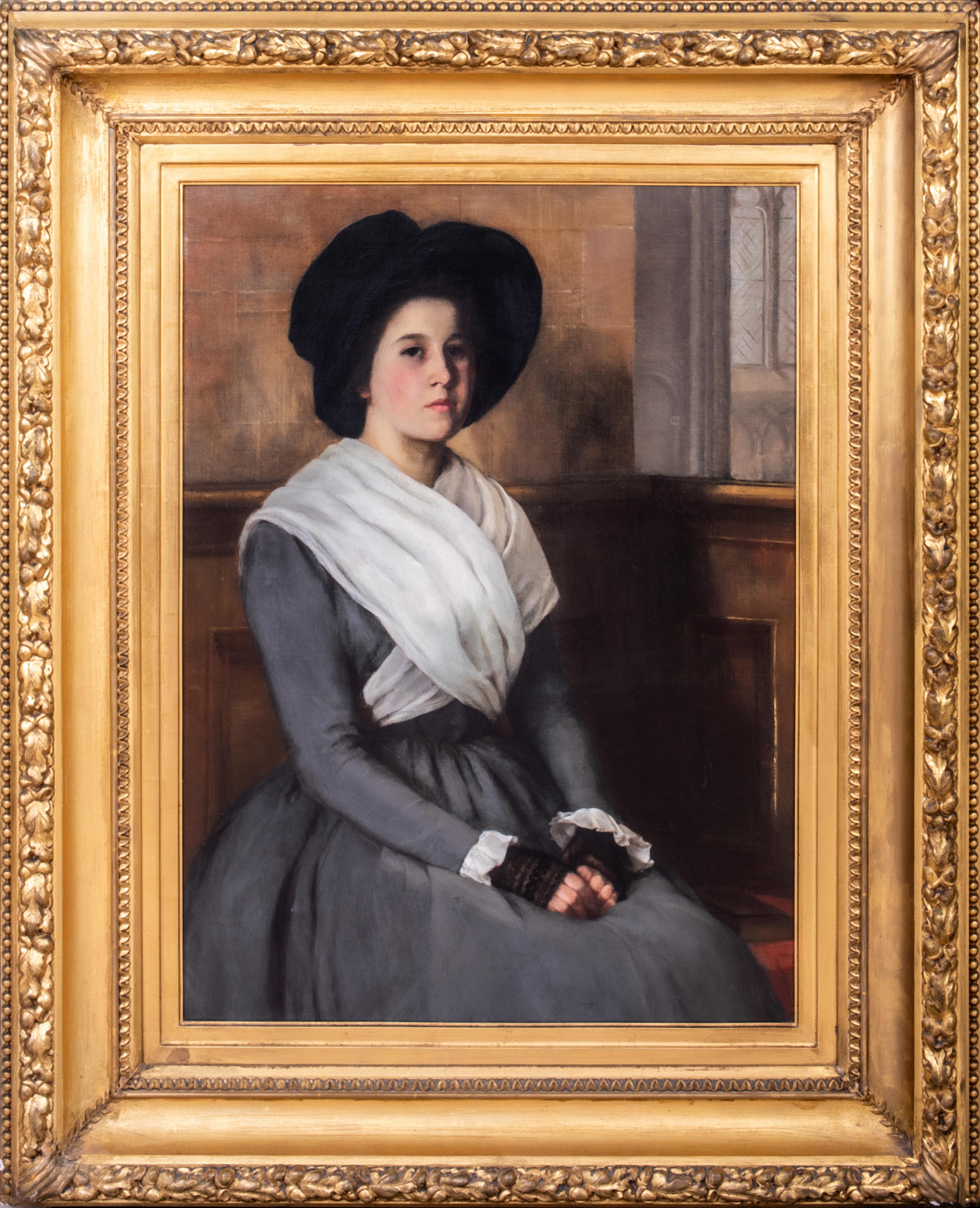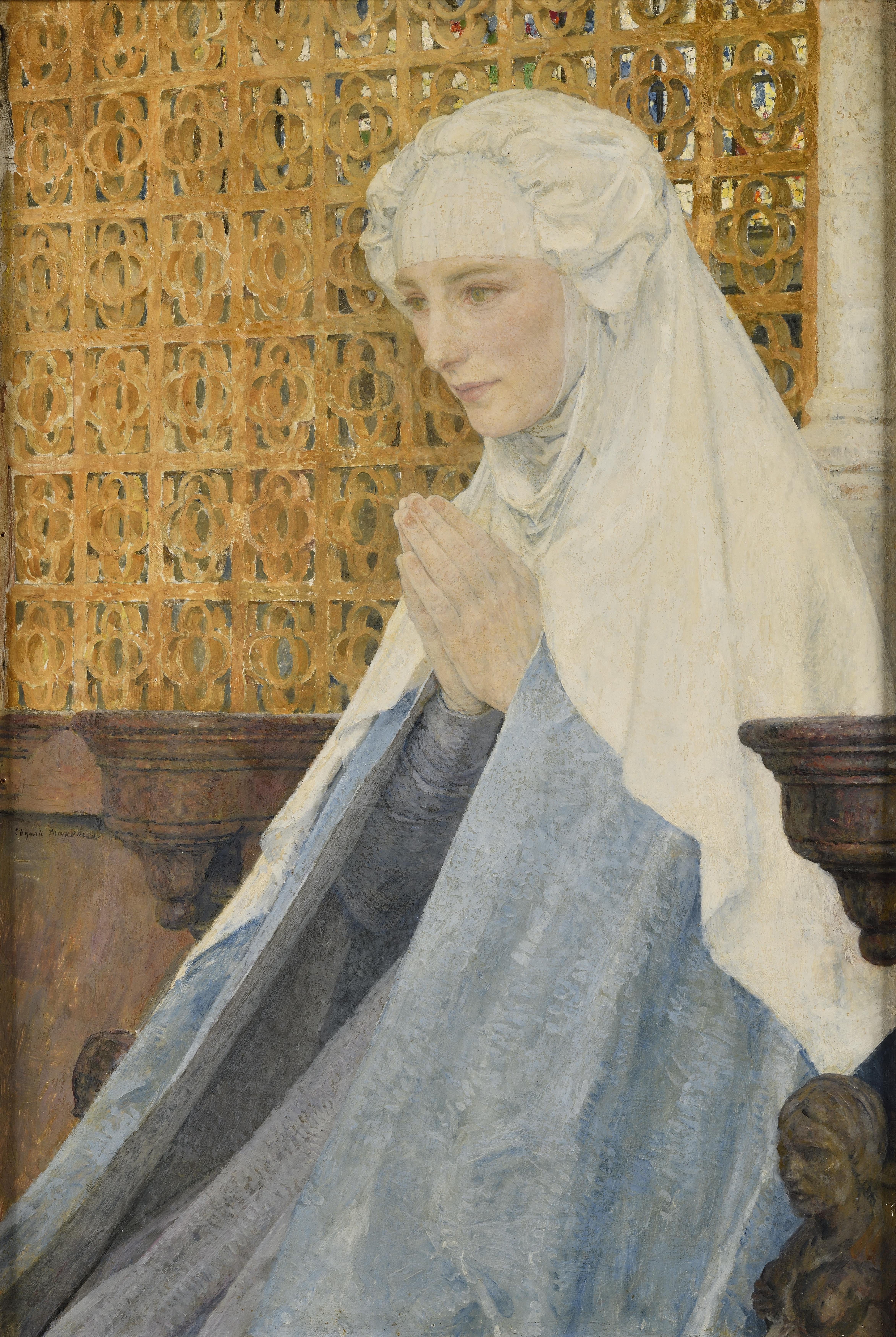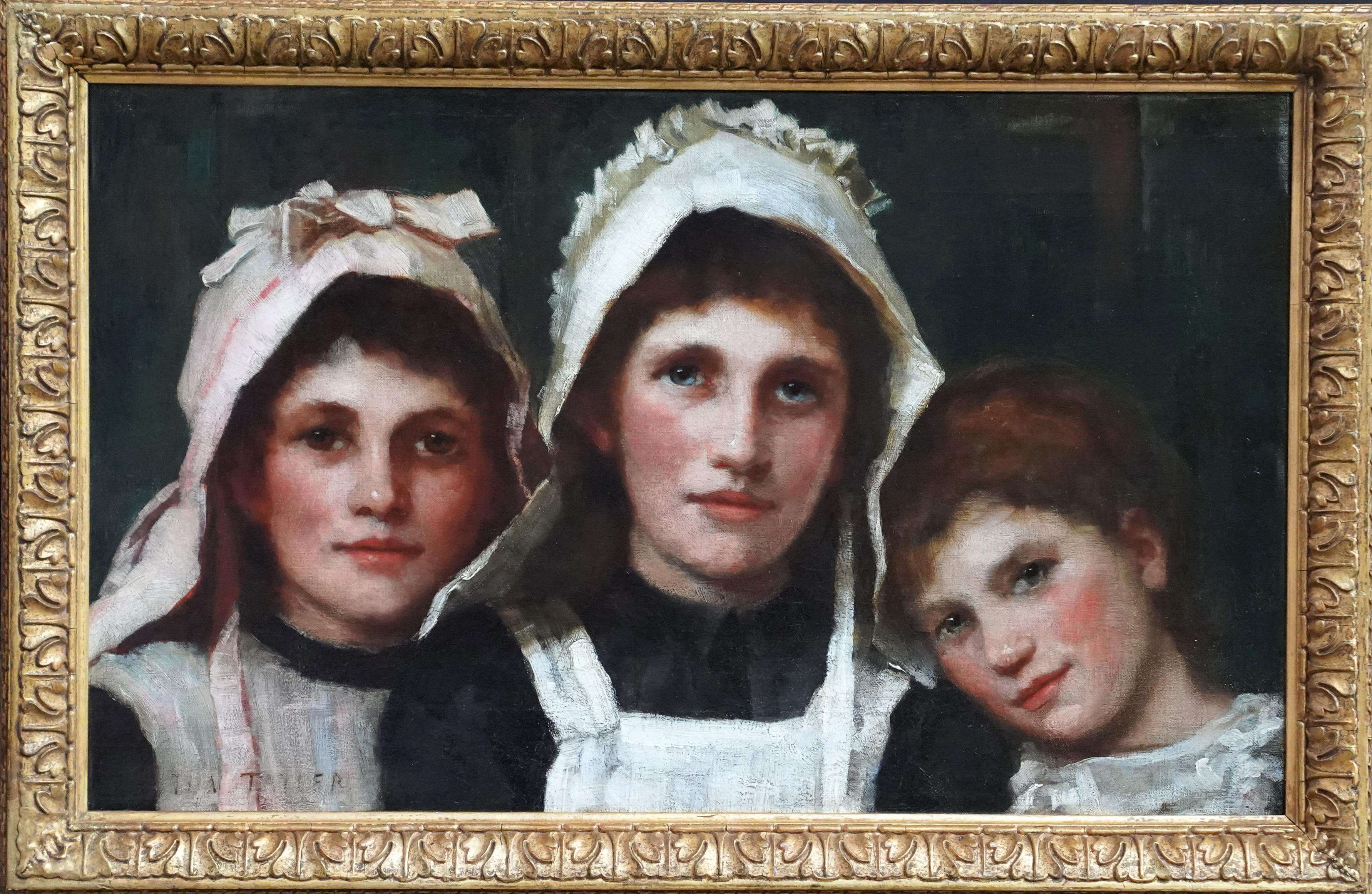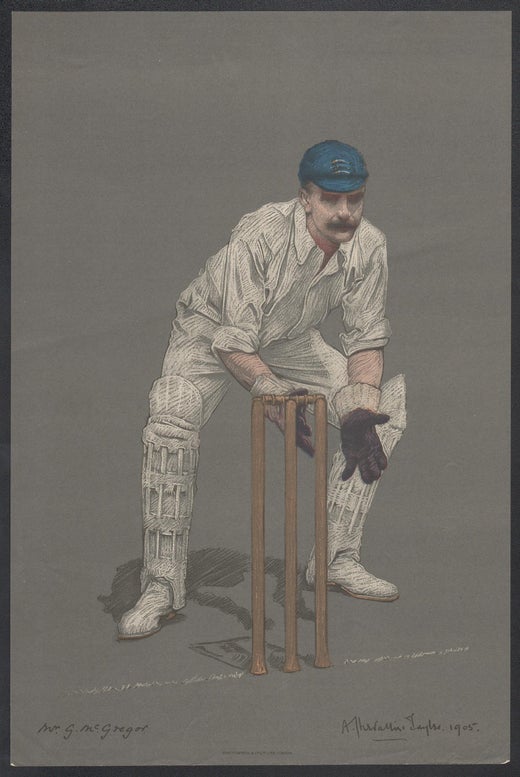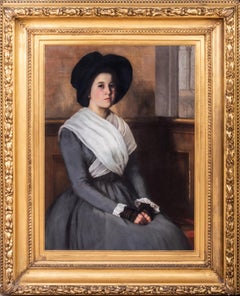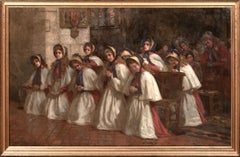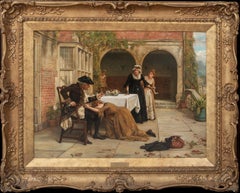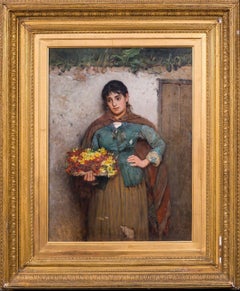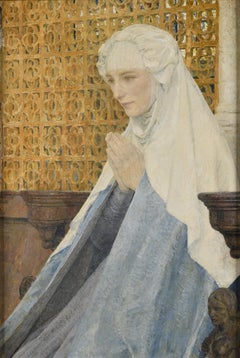Confirmation Day, dated 1892
by Albert Chevallier Tayler (1862-1925) - Exhibited 1892
Large 19th Century Newlyn School interior scene titled "Confirmation Day", oil on canvas by Albert Chevalier Tayler. The interior scene depicts the moment before a young girl will make her commitment to Christian faith. The work was exhibited on London in 1892 and comes with excellent provenance and supporting literature. Signed, dated and presented in a simple gold and black period frame. We had had the work professionally cleaned and restored.
Measurements: 43" x 35" framed approx
Provenance
The artist's niece to her nephew.
Thence by descent.
Private collection, South Africa.
Exhibited
London, Institute of Painters in Oil Colours, 1892, no 532.
Nottingham, Special Exhibition of Pictures by Cornish Painters, 1894, no. 211, illustrated.
Literature
'Art of the Week', Black and White, 5 November 1892, p. 536.
'Institute of Painters in Oil Colours', Evening Standard, 31 October 1892, p. 3.
'Art and Artists', The Gentlewoman, 5 November 1892, p. 30.
'Institute of Painters in Oil Colours', The Graphic, 5 November 1982, p. 558.
'Institute of Painters in Oil Colours', Illustrated London News, 12 November 1892, p. 620.
'Institute of Painters in Oil Colours', Leeds Mercury 31 October 1892, p. 8.
'Painters in Oil Colours', Morning Leader, 29 October 1892, p. 3.
'Institute of Painters in Oil Colours', Newcastle Chronicle, 27 October 1892, p. 8.
Illustrated London News, 4 March 1893, p. 268, illustrated.
'The Cornish Painters: Exhibition in Nottingham', The Nottinghamshire Guardian, 6 October 1894, p. 3.
David Tovey and Sarah Skinner, Cornish Light, The Nottingham 1894 Exhibition Revisited, Bristol, 2015, pp. 137-8, illustrated.
In August 1893 a reporter for The Sketch went in search of the Newlyn School. He was not the first to do so. Since the purchase of Frank Bramley's A Hopeless Dawn (1888) and Henry Scott Tuke's All Hands to the Pumps! (1889, both Tate), for the National Gallery of British Art, there had been a stream of journalists arriving in the fishing village to write about the group of painters - 'a colony of kindred souls' - who had made it their home. Strolling up the appropriately re-named "rue des Beaux Arts", The Sketch reporter encountered Albert Chevallier Tayler, a 'well-known face', and together they toured the village. Quizzed about the 'definition' of the so-called 'Newlyn School of Art', the artist was disingenuous. 'The critics say they can identify Newlyn work', he said, 'Perhaps they can: perhaps we who can see so much of one another and so much of one another's work have unconsciously adopted smatterings of one another's style.'1
For many critics, Tayler's Confirmation Day had been the classic Newlyn School painting, when first exhibited a year earlier and subsequently engraved for The Illustrated London News. Like A Hopeless Dawn it depicts a rustic cottage interior with women, young and old, consoled by Biblical verities. And while it lacks the former's 'hopeless' melodramatic vigil, when shown at the Institute of Painters in Oil Colours in November 1892, it was admired for its 'intense religious feeling'. Avoiding the pyrotechnics associated with currently fashionable Impressionism, it was seen to be 'excellently painted'. Sharp and suave in its handling, reporters particularly applauded the diaphanous quality of the girl's muslin dress that is so delicately painted. The ensemble was, according to the Morning Leader, 'absolutely faultless'.2
Only the Evening Standard obsessed over minor inconsistencies. While the chair and secretaire were 'English', 'the crucifix, placed prominently', it opined, 'suggests rather a French than an English interior'.3Consistency was, however, not an issue, for while the Newlyn fishing community was almost exclusively Primitive Methodist or Salvationist, it was not unusual for sailors to return from distant ports with foreign artefacts. This apart, Tayler's compositional furniture is familiar from many earlier works, such as The Letter, 1888 (sold in these rooms, 25 June 2014, lot 122).
Subject matter was nevertheless an important indication of the artist's background. The seventh son of a solicitor from Leytonstone in Essex, having trained at the Slade School of Fine Art under Alphonse Legros, Tayler, like his classmates, Tuke, George Percy Jacomb-Hood and Benwell Clark, decamped to the Paris ateliers where he fell under the influence of the Salon Naturalism of Jules Bastien-Lepage.4 This he brought to kindred spirits in Newlyn in 1884 – chief among whom was Stanhope Forbes – their shared ambition being to find a remote place, beyond the railway terminus, in which to work. From this point onwards, Tayler's talent was recognized. In 1887, the year he is thought to have converted to Catholicism, he was promoted by the ambitious London dealer, Arthur Tooth, who sent him to paint in Venice. There he encountered the work of Ettore Tito, Cecil van Haanen and members of the neo-Venetian school as well as their British counterparts, Henry Woods and Samuel Melton Fisher, probably at one of the weekly whist parties held by Horatio Brown.5
Despite demands from his patron, the young artist was fastidious, and, as occurred in 1892, he would hold back from exhibiting at the Royal Academy until he was completely satisfied that the works in hand met his exacting standard.6 Confirmation Day which may well have been shown earlier, was thus delayed until the 'Institute' show.
There was no doubt however, concerning the 'religious feeling' of this and other works by the artist. Since 1887, on more than one occasion, as here, observance of church ritual had been his subject matter.7 In this he was indeed closer to French than English sources, being probably familiar with Lepage's jewel-like La Première Communiante a work he could have seen as a student.8 However, of more immediate impact would have been Fisher's Una Cresima: The Confirmation of a Child, Venice, which was exhibited at the Royal Academy in 1891. Fisher had gone to Paris on a travelling scholarship when Tayler was also there in 1881, and it is likely that during their reunion in Venice six years later, he would have seen Fisher's The First Communion (unlocated) before its dispatch to the Academy. Thus, when the Venetian expatriate artist returned to the 'communicant' theme, the Newlyn painter must have taken special note.
As with Lepage, critics were impressed by Tayler's ability 'in dealing with white, and white on white, and against white'.8 An agreeable sense of abstraction, found here in the precise diagonal that takes the eye from the communicant's head to toe, is characteristic of the artist's finest work and it underscores a seriousness that was worn lightly in conversation with The Sketch reporter. It was, however, an exceptional eye and studied fluency that raises Tayler's work into direct comparison not only with French prototypes, but also with the Dutch masters of the Golden Age.
In 1895 Tayler left Newlyn for St John's Wood in north London. He returned to the present subject however, in 1900, when Ecce Agnus Dei was shown at the Royal Academy. Although much admired for its 'well-realised church interior', the painting lacks the intimacy of Tayler's earlier work, in which an older woman rehearses her responses with a young communicant.10 What was 'well-realised' in the later painting, now suddenly seems distracting, and the concentration of purpose in the present lot, is lost. Arguably Tayler would never regain the fine feeling of his last important Newlyn work, although he often worked to restore it.
1 Anon, 'Fishers and Painters', The Sketch 1 November 1893, p. 26.
2 'Art and Artists', The Gentlewoman, 5 November 1892, p. 30; 'Painters in Oil Colours', Morning Leader, 29 October 1892, p. 3.
3 'Institute of Painters in Oil Colours', Evening Standard, 31 October 1892, p. 3.
4 'Death of Mr A Chevallier Tayler: Famous Newlyn Artist', The Cornishman, 30 December 1925, p. 6. More recent accounts of Tayler's career have focussed on references drawn from the Forbes correspondence (Tate Archive); see Caroline Fox and Francis Greenacre, Painting in Newlyn, 1880-1930, 1985, (exhibition catalogue, Barbican Art Gallery), pp. 71-2. Forbes in his valedictory tribute to his old friend, describes Tayler as a 'fine talent' and a person of 'extraordinary charm'; see 'Mr Chevallier Tayler: Tribute to a Distinguished Painter', Western Morning News, 29 December 1925, p. 4.
5Kenneth McConkey, Towards the Sun, The Artist-Traveller at the Turn of the Twentieth Century, 2021, (Paul Holberton Publishing), pp. 125-6.
6 Reported in The Tablet, 7 May 1892 p. 7, and other sources. 7 Such works as the cottage interior Bless, Oh God, These Thy Gifts, 1888 (Private collection) may be cited in this regard.
8 Bastien-Lepage's La Première Communiante, 1875, was shown in his small retrospective at the Grosvenor Gallery, London in 1880 (no. 8). Communicants were of course a familiar Salon subject seen in the work of Henri Gervex, Léon Lhermitte and Jules Breton.
9 'The Cornish Painters – Exhibition in Nottingham', Nottinghamshire Guardian, 6 October 1894, p. 3.
10 'The Royal Academy', St James's Gazette, 21 May 1900, p. 5. In format, Ecce Agnus Dei, echoes Melton Fisher's The First Communion (unlocated), shown at the Academy in 1887, and reproduced in The Graphic.
We are grateful to Professor Kenneth McConkey for compiling this catalogue entry.



